A panel of industry experts weighs in on recent and future advances in laser technologies for machine vision, and offers a look at the market.
Laser-based machine vision can be a valuable tool for manufacturers looking to improve various areas of production: prototyping, assembly, inspection and the like. The technology enables better 3-D visualization throughout the manufacturing process, and it’s constantly evolving.
To get an in-depth perspective on both the technology and the market for lasers for machine vision, Photonics Spectra interviewed representatives of several companies that are big players in the machine vision sphere: Terry Arden, CEO of LMI Technologies in Delta, British Columbia, Canada; Song Chung, vice president of engineering at Perceptron in Plymouth, Mich.; Michael Dunbar, director of business development at Neptec Technologies of Ottawa, Ontario, Canada; Mike Faulkner, director of sales and marketing at Z-Laser America Inc. in Montreal; José Angel Gutiérrez Olabarria, machine vision projects manager at Tecnalia Research & Innovation in Derio, Spain; Wallace Latimer, product line manager for machine vision at Coherent Inc. in Wilsonville, Ore.; Dr. Artzai Picon, computer vision researcher at Tecnalia; Michael Rigney, staff engineer in the Robotics and Automation Engineering Section of the Manufacturing Systems Department at Southwest Research Institute (SwRI) in San Antonio; and Bob Tremblay, manager of product marketing at Cognex Corp. in Natick, Mass.
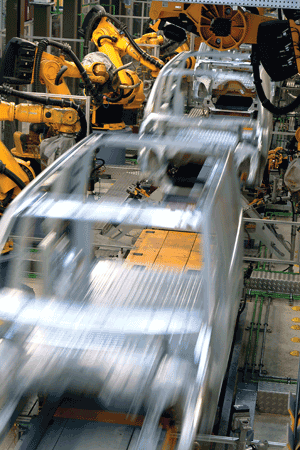
Machine vision lasers enable automotive process optimization. Photo courtesy of Coherent Inc.
Q: What do you see as the “next big thing” in lasers for machine vision, in general?
Gutiérrez: Price, power, robustness (temperature, hard environments), quality (low speckle, uniformity).
Tremblay: Certainly, as 3-D laser displacement sensors become easier to use and deploy, we’ll see increased use of lasers in machine vision applications such as 3-D part inspection, volume measurement and surface flaw detection.
Rigney: Cost reduction of high-power lasers is enabling their application to new processes. Reduced size and weight of laser systems is also important, as we are developing solutions integrated with mobile robotic manipulators. Coating removal from commercial and military transport aircraft, for example, is enabled by a mobile robot/laser/vision system moving around the aircraft within a large workspace.
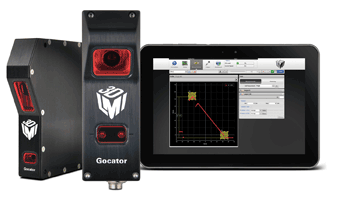
Laser-based, noncontact optical 3-D measurement sensors such as the Gocator from LMI Technologies are designed for various industrial applications. Photo courtesy of LMI.
Picon: In the case of measurement- and quality-control-based applications, laser durability, linearity and stability are still major problems for online hot-product measurements.
Dunbar: I think the next big thing will be the continued path toward smaller and more highly integrated positioning solutions at lower price points to enable broader deployment in air, land and sea environments.
Arden: Laser-based triangulation sensors have developed to a mature level of use in a variety of in-line measurement applications. It is a well-established technology used where 3-D is needed to perform inspection or optimization. The next big thing will be a move towards shorter-wavelength blue lasers to reduce reflections from shiny parts. Another trend I see is the move to drive price performance to a new level, where the price/performance of 3-D can replace 2-D smart cameras – offering a calibrated grayscale image from the reflected laser light for 2-D image processing as well as the 3-D height map for 3-D processing.
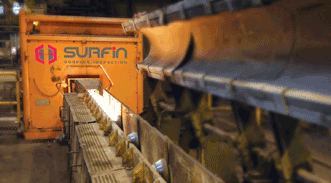
Machine-vision-based surface inspection and triangulation sensors enable 3-D measurements for hot conditions. Photo courtesy of Tecnalia.
Faulkner: Quality of the line specifically improving the uniformity; i.e., reducing the “bunny ears” effect typically found in Powell line optic projections. Another is robustness in regards to environmental situations like extreme temperatures, dust and liquids affecting the laser’s performance.
Chung: Full 3-D scanning-based applications in the areas of inspection, reverse engineering and rapid prototyping in support of 3-D printing industry. More advanced algorithms to enhance the data collection with higher resolution and higher accuracy, taking advantage of the advancement of SOC (system on chip) processing power available due to mobile computing technology development – i.e., 3-D scanning on a mobile phone.
Latimer: In terms of technology, one of the most important emerging trends is the development of increasingly high power, reliable sources in the blue-green end of the spectrum. Also significant is the introduction of increasingly more compact and highly functional laser sources, which enables them to be mounted directly on robot arms. Traditionally, sophisticated vision systems have been built on large mechanical gantries, and the parts run by underneath. These systems might incorporate dozens of sensors to allow a variety of inspection tasks to be performed. But now, the trend is away from this and towards having a number
of smaller, individual robots on the production line. Each of these robots is able to move independently and therefore
look all around a part. This approach is becoming more popular because it reduces the number of sensors required, thus lowering cost while also increasing system flexibility. That is, by executing a different set of movements, a variety of part types can be examined by a single robot.
This market demand for flexibility also translates into downward pressure on laser price. A laser at a specific power and wavelength may be good for one task and not another. Therefore, building more flexible and capable machine vision systems may require multiple lasers with various wavelength, power, output beam and optomechanical characteristics. But, of course, system builders want to add all this functionality for a minimum incremental cost.
Q: How would you say the market has been in the past few years for lasers for machine vision? Where do you think the market is going?
Gutiérrez: I think it is growing, even in the crisis.
Dunbar: There has been and continues to be a shift toward more intelligent systems that perform a function other than just producing X million points.
Chung: More sensor companies are moving on to development of 3-D line scanners, taking on more complex vision applications. Industrial 3-D vision applications will become much more widespread in the coming years.
Tremblay: Well, if you are talking about bar-code reading in logistics, food and beverage, or even retail, there is certainly a downward trend as more and more laser-based scanner systems are displaced by image-based readers. Image-based readers not only work better, but they also achieve higher read rates, provide performance feedback, and don’t have to be replaced as often because they have no moving parts. In contrast, the machine vision side is on an upward trend, as our DS1000 3-D sensor pairs the laser with a 2-D image sensor to create a 3-D topographical representation which can measure and inspect features to micron-level accuracy.
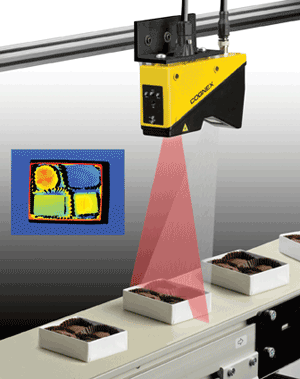
Food inspection and other industrial applications benefit from 3-D laser displacement sensors. Photo courtesy of Cognex Corp.
Faulkner: Laser-based applications in machine vision have been very healthy despite the economic conditions. The market for [our] products has more than doubled in the past years, and the trend continues to grow.
Arden: Over the past few years, there has been exceptional increase in demand for laser-based machine vision. In part, this is due to an overall lowering of cost for noncontact 3-D measurement sensors. We are driving ease of use to enable this technology in greater use on the manufacturing floor by process engineers. With lower noise and more sensitive camera technology, laser power can be reduced to an eye-safe Class 2 rating, making sensors easier to deploy. Blue-laser-based measurement is beginning to gain popularity because of lower noise and shorter wavelength properties that reduce reflections that occur on shiny part surfaces.
Picon: More advanced applications such as real-time hot (>1000 ºC) product quality assessment, including complex artificial intelligence algorithms, are growing. Material classification or biomedical diagnosis applications (e.g., laser-induced breakdown spectroscopy (LIBS), fluorescence, Raman spectroscopy) are also growing, especially in the biomedical sector, where final applications are being demanded rather than just R&D projects.
Rigney: The proliferation of laser modules and components for structured lighting is exciting. We look forward to greater diversity in component configurations, which can reduce the development cost for systems with unique requirements.
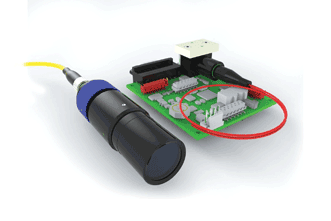
Fiber-laser-based machine vision solutions offer versatility and improved line resolutions for industrial uses. Photo courtesy of Z-Laser.
Latimer: Obviously, the recent recession put a dent in the machine vision market, but now it is back at its previous growth levels, which have traditionally been in the upper single digits. However, I certainly see great things ahead. Particularly, the potential for growth in Korea and China is huge as manufacturers in these countries move their production from a labor-intensive model to more highly automated processes with an increasing emphasis on end product quality and reliability. This presents great opportunities for machine vision. There will be more widespread adoption in these areas as machine vision component costs come down.
Also, I see the potential for machine vision products to expand into areas which they have not traditionally serviced. The
classic machine vision task is one in which the system is used to visualize mechanical items in order to control an action during production. But I think that these same products could also expand into tasks I classify as automated imaging. In this case, they act essentially as a vision system for computers, enabling them to do complex tasks traditionally performed by humans. This could be monitoring and evaluating all sorts of things, like traffic, trains and airplanes, or even interpreting medical images.
Q: What are the biggest challenges to adoption of lasers for machine vision?
Gutiérrez: For the industrial sector: price, robustness and stock.
Dunbar: Size, price and acceptance of new technologies in traditional markets.
Picon: For quality-control applications on hard conditions – such as hot steel product inspection – durability, linearity and stability of the lasers that implies short-time laser replacement. In the case of high-precision 3-D measurement applications, it involves a tedious calibration each time a laser is replaced.
Tremblay: Some are initially concerned about laser safety, of course. However, once they realize that our lasers are essentially eye-safe when operated properly, this is usually a nonissue.
Rigney: Laser safety is a potential challenge. Our clients have widely varying backgrounds with laser applications. [We have] extensive expertise in the definition of and compliance with the laser safety requirements for the systems that we develop.
Arden: The biggest challenge is teaching the value of laser-based scanning as a means to develop both 2-D and 3-D data for more effective solutions to tough inspection problems. This can be met by focusing on ease of use and putting “smart” capabilities into a sensor design. What I am referring to as “smart” is the ability to take 3-D measurement and make control decisions (sorting, pass/fail, alerts) all within a single precalibrated device. This enables easier and successful deployment by process engineers and not highly specialized machine vision integrators. This is the reason we created the Gocator product line.
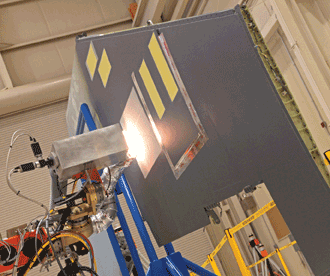
This is a prototype demonstration of a machine-vision-controlled laser-based selective coating removal system. Photo courtesy of Southwest Research Institute.
Faulkner: I think the biggest challenge for lasers in machine vision is the same as [for] 2-D machine vision: finding new applications inside and especially outside of the plant floor. We have found many new “out of the plant floor” applications where our high-intensity [laser projectors] have been very well received by the market.
Chung: Cost and ease of use in solution implementation. Traditionally, machine vision solutions are still relatively expensive and difficult to implement. These obstacles can be overcome as more companies are working to overcome the challenges aggressively.
Latimer: Sadly, I think that our biggest problem is not technological, but rather the lack of education about laser safety
in the market. This causes potential customers to avoid using lasers because they are ’t sure how to manage them. So, education of the market is clearly a critical need here.
Also, there’s inertia in the market. People who have traditionally used fluorescent lights or LEDs for their application are reluctant to move to a laser source because the initial cost is usually higher. Sometimes, it’s hard for them to see that there might be a substantial savings over time with a machine vision laser because they might enable more rapid inspection or improved results.
Q: And which application areas would you say are thriving – and why?
Gutiérrez: Triangulation and measurement. 3-D information is more important every day.
Arden: Large-volume laser-scanning applications in harsh industrial environments are thriving. An example is the forest industry. Sawmills have high volumes of fast-moving products that must be scanned for shape to determine the best strategy for cutting logs into finished lumber.
Faulkner: Although we work in application areas like automotive, medical, general manufacturing, biophotonics, etcetera, we are seeing healthy growth in all application areas. The resurgence in reshored manufacturing has created a large demand for automation as part of the quality control process.
Chung: Complex and highly configured applications of vision technology are still the mainstream applications for vision system suppliers, but more and more off-the-shelf and ready-made solutions could become the mainstream in the coming years due to advancement in the adoption rate of the technology in the consumer market.
Dunbar: Machine automation in mining is thriving because the return on investment with high-capital expenditures
is so compelling, along with the safety improvements in and around the vehicles.
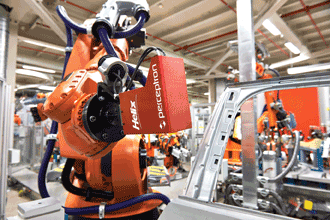
Laser-based machine vision technologies offer process improvements for the automotive and other industries. Photo courtesy of Perception.
Tremblay: Thriving application areas include consumer electronics, automotive, food, beverage and logistics, where the 3-D information provided allows for more complete inspection of the part.
Rigney: 3-D sensing applications are thriving due to the availability of sufficient processor performance and mature software libraries for real-time analysis. Recent proliferation of low-cost 3-D sensors (incorporating laser pattern generators) has enabled new application domains to be developed. 3-D perception supports much of our work with fixed-base and mobile robot applications in dynamic environments.
Picon: Surface online inspection of hot products is growing fast. Besides this, online chemical characterization of materials and products applications (based on hyperspectral imaging or LIBS) are showing great potential. The requests for these kinds of applications have grown by 50 percent in 2013.
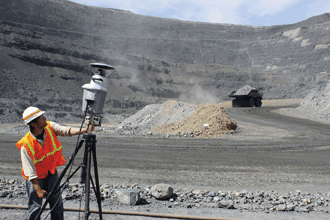
Vision-based automation offers mining companies a compelling return on investment as well as safety improvements. Photo courtesy of Neptec.
Latimer: There are several segments that are growing. One is semiconductor inspection. This is partly because the entire semiconductor business is on an upcycle. But, also, integrators are being asked to perform more inspection, and they’re seeing positive results using machine vision technology. Much of this is driven by consumer products such as smartphones and tablets. The consumer has a very high expectation for quality and functionality in these products, so this puts a burden on the manufacturer to implement improved process-control techniques, and to perform ever-more-rigorous inspection.
Glass inspection is also a growth area, again being driven mostly by the display market for consumer electronics. Glass is being increasingly utilized in displays, and manufacturers are increasingly intolerant of even submicron defects. This increases the need for automated inspection.
Another rapidly developing application is transportation and infrastructure inspection. Specifically, this is the use of machine vision systems for more time-efficient inspection of tunnels, bridges and train rails, wheels (as they move) and brakes. The commuter rail industry in particular is really focusing on safety. Traditionally, they’ve had people physically walk out and inspect things like rails, and a human inspector might be able to cover about five miles of track in a day. An automated system can inspect 100 miles a day. That makes the technology extremely attractive to the market.
Machine vision tools
• Cognex makes 3-D laser displacement sensors.
• Coherent makes diode-laser-based systems based on 3-D triangulation, and also offers standard and custom diffractive optical components.
• LMI makes laser-based, noncontact optical 3-D measurement sensors for various industrial applications.
• Neptec manufactures laser scanners and related real-time software.
• Perceptron offers laser triangulation sensors for 2-D and 3-D in-line vehicle quality control as well as reverse engineering and rapid prototyping.
• SwRI is a contract engineering services provider that develops various custom machine vision solutions as well as machine vision for control of laser-based processes.
• Tecnalia produces vision-based automated surface inspection and triangulation sensors (3-D measurement), mainly for hot conditions.
• Z-Laser produces laser line projectors for 3-D vision applications (output intensities: 1 to 6000 mW; wavelengths: 404 to 980 nm).